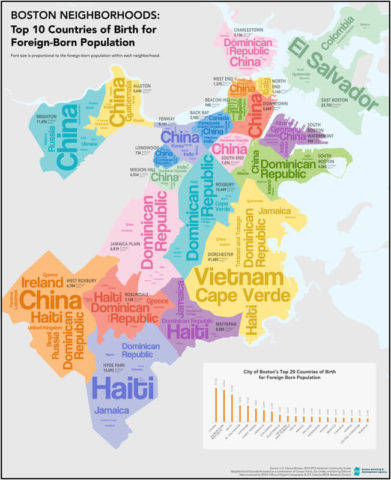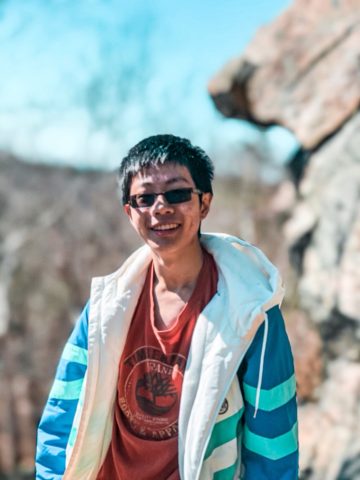The New Bostonians
The New Bostonians Overview

The New Bostonians
Boston has always been a city of immigrants. Yet for as much attention given to Boston’s Irish and Italian past, an equal measure deserves to be given to the immigrants who have transformed Boston today—Haitian, Vietnamese, Dominican, Chinese, Cape Verdean, Colombian, Brazilian, Nigerian, Indian… the list goes on. How important are these new Bostonians? Thirty percent of Boston’s population are immigrants. From 2017 backwards, immigrants comprised 90 percent of the city’s growth in the past 30 years.
These immigrants often inhabit overlooked spaces in Boston. Their neighborhoods marginalized and their stories ignored, quietly working to elevate the next generation and to build communities that can stand up for themselves. In this project, four immigrant groups are highlighted: Haitians, Chinese, Cape Verdeans, and Dominicans. Together, they represent a diverse mix of ethnic origins (Latino, Asian, African), cultures, and geographies. While they are only a small cross-section of the diversity that exists in the city among immigrants, these four groups represent a new Boston: a diverse city powered by immigrants, deconstructing old barriers and making new strides toward the future.

Who is Boston?
For most residents of the city of Boston, the heart of Boston is not Downtown. The heart of Boston is Dorchester. It is Mattapan. It is Roxbury, Hyde Park, Roslindale, Jamaica Plain. These neighborhoods are the fastest growing in Boston, and are the largest in both area and population. They are the beating heart of the city, where corner barber shops, restaurants, and local nonprofits are transforming life for the city’s most underserved communities. Yet too often they are ignored, hidden behind barriers that make us uncomfortable when we even mention them, much less visit there in person.
I go to school in Dorchester, one of the most diverse neighborhoods in Boston. I claim a share of Boston by being here, a stake that makes it our responsibility to be present within the lives of the people surrounding us, not just around them. Maps are powerful because they allow us to literally put people and places on the map. People and places that we may not have noticed before, or perhaps subconsciously un-noticed. These immigrant communities share many of the same struggles, and are composed of residents full of tremendous resilience, hope, joy, and love.
So who is Boston? I am Boston. You are Boston. Immigrants are Boston. We are Boston.
Themes of Oppression, Loss, Unity, Growth
Despite the many differences between the immigrant groups I studied, common themes united all of them. Every immigrant group faced tremendous racial discrimination and systemic obstacles to success in Boston, and showed an equally tremendous resiliency and hopefulness to push through those obstacles. Boston has always been a city with deeply-rooted racial barriers, many of which—policies of segregation, housing, and “urban renewal”—have left lasting constraints on where new immigrants can live, where they can send their children to school, what goods they can buy, and who they can elect. Despite Boston’s progressive history, these issues persist as an ugly reminder of how universal prejudice can be.
The evolution of immigrant neighborhoods share many common features. Gentrification and redevelopment have challenged all of these immigrants’ abilities to build lasting communities in one place. Violence within immigrant communities has scarred all of the communities I explored. Additionally, violence between immigrant communities also exists. However, strong community organizing groups and civic leaders have emerged across these communities at the same time, providing resources, mutual support, and solidarity for neighbors from other immigrant nations. Eventually, spaces where people were once relegated become spaces where people are celebrated, and vacant lots turn to playgrounds, and wellsprings of culture become oceans of people bound by heritage and place.
Themes of Development and Displacement
Today, Boston’s City Hall no longer pitches urban renewal projects that displace residents and replace them with warehouses or flashy corporate office buildings. Redevelopment and housing have become primary concerns for a Planning and Development Agency now focused on equitable access for immigrants. Boston’s Chief of Economic Development, John Barros, is the son of Cape Verdean immigrants (and a BC High alum). Yet issues such as gentrification and skyrocketing housing prices still persist, making it harder for immigrants to put down lasting roots in the City. The future of ethnic squares, business districts, and affordable apartments remain uncertain as large developers move in and immigrants move out.
Another aspect of Boston’s history has been instrumental in sustaining Boston’s status as a city of immigrants for centuries: the triple-decker home. Triple-deckers have been key to helping immigrants find affordable housing since the first Irish and Italian settlers came to Boston, and offer new immigrants a chance to become landowners, to pay off mortgages by renting the other two floors, and ultimately, to boost their economic status in the city. Living in triple decker homes has been a common experience for immigrants in Boston across ethnic, cultural, and generational lines.
Themes of Loss and Hope
In Chinatown, one of the oldest ethnic neighborhoods in Boston, thriving businesses and nonprofits have overcome the gangs that long ago embezzled money from business owners. Violence within the tight-knit Cape Verdean community can be tragic when family members attack each other, but during the COVID-19 pandemic, Cape Verdean restaurant Nos Casa partnered with local non-profits to offer free meals to struggling families within the community. Haitians and Dominicans have historically had tense relations on the island, but in Boston, Haitian and Dominican artists from the Hyde Square Task Force partnered to create art seeking solidarity between the two groups. These are just a few examples of the resiliency and strength that can be drawn from strong cultural ties.
Themes in Conclusion
All of these immigrant groups have struggled with institutional oppression, violence within their own communities, and relationships with other immigrants. Each of these barriers are complex, but together, these groups are overcoming such obstacles to bring forth the vision of a truly Greater Boston: one that celebrates diversity and unites people of all backgrounds as one Boston.
About the Begley Scholar
Roy Zhu ’21
As the son of two Chinese immigrants, I have always been interested in the stories of foreign-born Americans. My parents came to America in the 90s and early 2000s, leaving their families and connections behind and starting anew in Boston. They navigated a strange world and unfamiliar culture with grit and perseverance; their story is one shared by every new group of immigrants. Growing up, I wrestled with questions of my identity and my overlapping cultures. I hope this resonates with many who share in the immigrant experience. Today, I am a senior at BC High, and I lead the Mock Trial and Quiz Bowl teams at school. I participate in a wide variety of clubs and activities, including Youth and Government, the school newspaper, and Asian Culture Club. As BC High has focused more on empowering the marginalized and fostering inclusion in its own community, I feel that the time is right to begin recognizing some of the people groups that have enriched our city (and our school) with their stories and heritage.
Acknowledgements
I would like to take the time to thank a number of people and groups for their generosity, support, and assistance over the course of my project. My advisor and history teacher, Dr. Nicholas Argento, was instrumental in making sure every part of this project could reach its potential. Mrs. Colleen Carter, BC High’s Vice President for External Relations, put together all the technical components of this website. My friend and photographer Erin Leone (NDA ‘21) took photographs of Mattapan and the Mt. Hope Cemetery for this project. I especially hope to acknowledge everyone who was willing to be interviewed for this project, including The Honorable Judge Serge Georges ’88, Pastor Cesar Depaz of the Hispanic Community Church of Boston, Joshua Fidalgo ’08, Dr. Regine Jackson, and many others from various small businesses and community organizations who kindly offered their wisdom and assistance.

